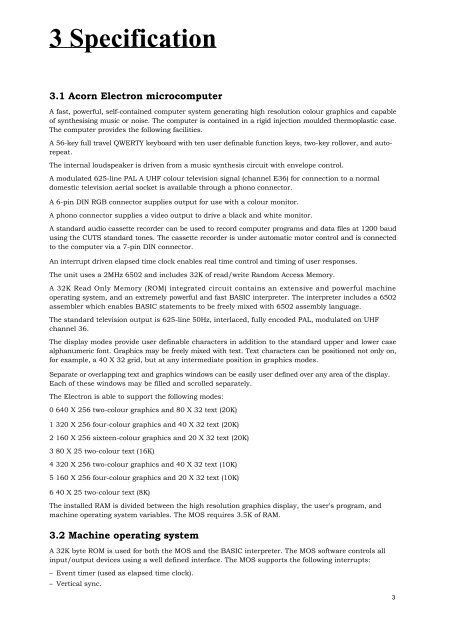You also want an ePaper? Increase the reach of your titles
YUMPU automatically turns print PDFs into web optimized ePapers that Google loves.
3 Specification<br />
3.1 <strong>Acorn</strong> <strong>Electron</strong> microcomputer<br />
A fast, powerful, self-contained computer system generating high resolution colour graphics and capable<br />
of synthesising music or noise. The computer is contained in a rigid injection moulded thermoplastic case.<br />
The computer provides the following facilities.<br />
A 56-key full travel QWERTY keyboard with ten user definable function keys, two-key rollover, and autorepeat.<br />
The internal loudspeaker is driven from a music synthesis circuit with envelope control.<br />
A modulated 625-line PAL A UHF colour television signal (channel E36) for connection to a normal<br />
domestic television aerial socket is available through a phono connector.<br />
A 6-pin DIN RGB connector supplies output for use with a colour monitor.<br />
A phono connector supplies a video output to drive a black and white monitor.<br />
A standard audio cassette recorder can be used to record computer programs and data files at 1200 baud<br />
using the CUTS standard tones. The cassette recorder is under automatic motor control and is connected<br />
to the computer via a 7-pin DIN connector.<br />
An interrupt driven elapsed time clock enables real time control and timing of user responses.<br />
The unit uses a 2MHz 6502 and includes 32K of read/write Random Access Memory.<br />
A 32K Read Only Memory (ROM) integrated circuit contains an extensive and powerful machine<br />
operating system, and an extremely powerful and fast BASIC interpreter. The interpreter includes a 6502<br />
assembler which enables BASIC statements to be freely mixed with 6502 assembly language.<br />
The standard television output is 625-line 50Hz, interlaced, fully encoded PAL, modulated on UHF<br />
channel 36.<br />
The display modes provide user definable characters in addition to the standard upper and lower case<br />
alphanumeric font. Graphics may be freely mixed with text. Text characters can be positioned not only on,<br />
for example, a 40 X 32 grid, but at any intermediate position in graphics modes.<br />
Separate or overlapping text and graphics windows can be easily user defined over any area of the display.<br />
Each of these windows may be filled and scrolled separately.<br />
The <strong>Electron</strong> is able to support the following modes:<br />
0 640 X 256 two-colour graphics and 80 X 32 text (20K)<br />
1 320 X 256 four-colour graphics and 40 X 32 text (20K)<br />
2 160 X 256 sixteen-colour graphics and 20 X 32 text (20K)<br />
3 80 X 25 two-colour text (16K)<br />
4 320 X 256 two-colour graphics and 40 X 32 text (10K)<br />
5 160 X 256 four-colour graphics and 20 X 32 text (10K)<br />
6 40 X 25 two-colour text (8K)<br />
The installed RAM is divided between the high resolution graphics display, the user's program, and<br />
machine operating system variables. The MOS requires 3.5K of RAM.<br />
3.2 Machine operating system<br />
A 32K byte ROM is used for both the MOS and the BASIC interpreter. The MOS software controls all<br />
input/output devices using a well defined interface. The MOS supports the following interrupts:<br />
– Event timer (used as elapsed time clock).<br />
– Vertical sync.<br />
3

















